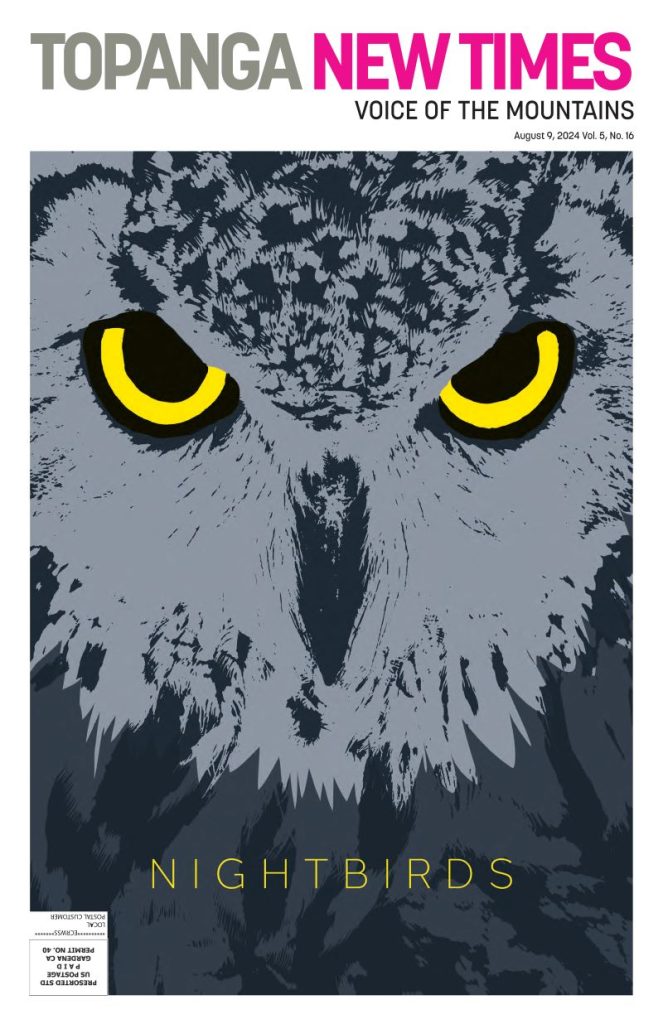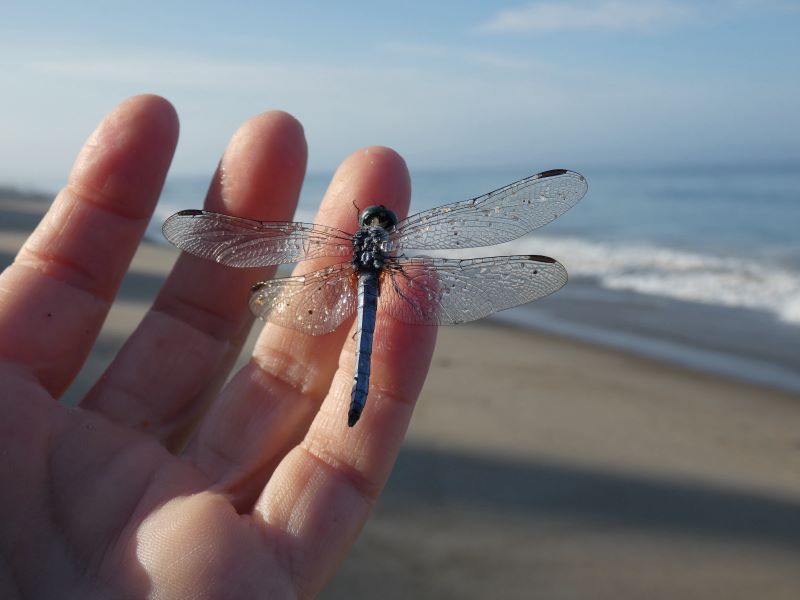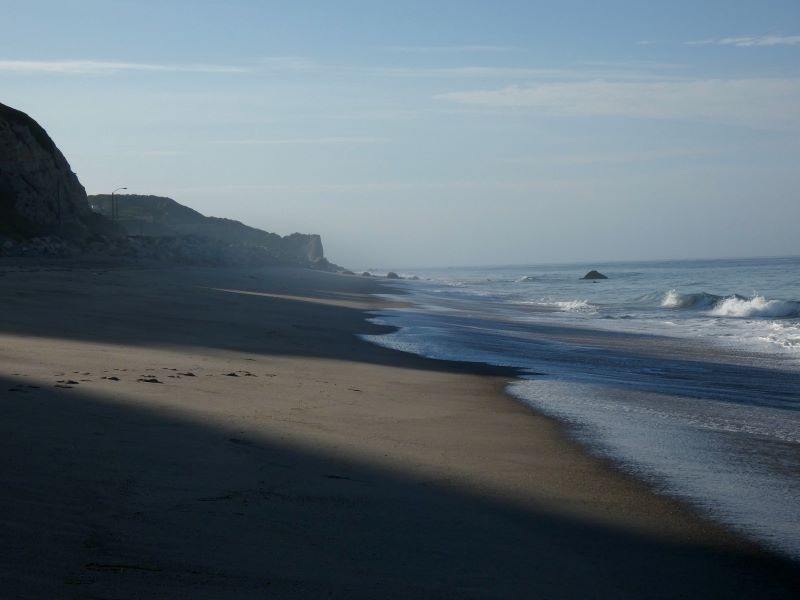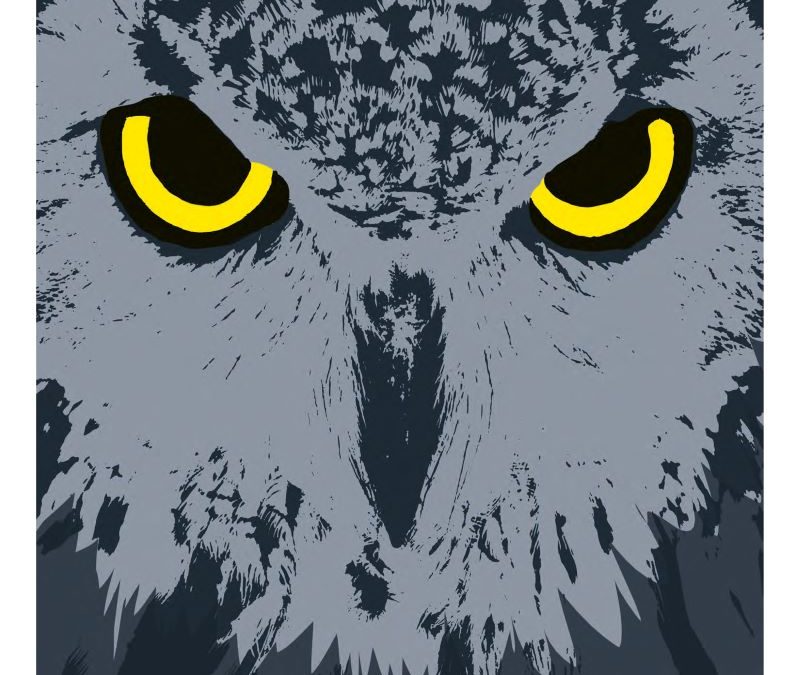
We’ve all heard them in the still hours after sunset and before sunrise, but who are the birds that call to each other in the darkness of a Topanga August night? Owls? Certainly! But not all night owls in the Santa Monica Mountains are owls. Join TNT for a look at the mysterious lives of the local nightbirds. Cover concept and design by Urs Baur.
August is a restless month. The sunshine in the garden is filled with the quick darting movement of dragonflies, wasps, and the fidgety small butterflies of summer—skippers, blues, and whites. There are cobwebs in the morning, stretching across the front door or the driveway. The annual crop of orbweavers have already graduated from small insects and begun spinning webs to catch bigger prey. This is the month for shooting stars at night, and for monsoonal air that brings vivid sunsets and the southern swell up from the tropics, but it is also the month with the hottest weather, in a summer that has already broken heat records.
This year, the extended heat is bringing elevated fire risk. High temperatures have helped fuel several small but still worrisome fires in and around the Santa Monica Mountains—most recently, a two-acre fire in Encinal Canyon. Heat continues to drive a monstrous conflagration in Northern California. The Park Fire has burned more than 400,000 acres across Butte, Plumas, Shasta, and Tehama counties. It’s now the fourth biggest wildfire in California history, and it’s still less than 50 percent contained.
Most of us who live in high fire areas in Los Angeles County have already received our fire department letters stating that our property has either passed fire clearance inspection or that it needs more work. That work has added urgency this year, as we hurtle towards the most dangerous and potentially deadly season for fire. It’s important, however, to keep an eye out for wildlife while clearing brush and trimming trees. Tree squirrels and many songbirds are still nesting, and there are less pleasant surprises this time of year, like the potential for yellow jacket nests in the soil, and paper wasps in the trees. Grass spiders can also deliver a painful sting and are abundant in the garden. This has already been an active season for rattlesnake encounters. Being aware of what’s going on and alert to the presence of animals and insects can help prevent problems. It’s a good idea to wear gloves, a long sleeved shirt and closed-toe shoes while working in the yard, even when it’s hot. Being careful to never reach or step into deep brush—or deep shadow—can help prevent unwelcome snake encounters.

Pesky insects and venomous snakes aren’t the only thing to worry about this month. August is bringing another unwelcome trend: a major increase in the number of COVID-19 cases. The culprit? FLiRT, an acronym made up from the family of sub-variants of the virus that are currently proliferating. FLiRT is an unfortunate acronym. It sounds innocuous and rather twee, but it still has the potential to be extremely nasty. Currently, one subvariant, KP 3.1.1, appears to be dominating in California. It is highly contagious, and the symptoms include the potential for an extremely painful sore throat and a persistent cough.
Here at TNT we’ve been grateful not to have to report on or warn about COVID for almost a year. We all want to put the pandemic behind us, but this disease has made it clear that it is here to stay, and this August the numbers are continuing to climb, putting the virus back in headlines and into our consciousness. Public health officials recommend opting for outdoor activities, washing hands frequently, wearing an N95 mask when flying or in a crowded environment, and taking extra precautions with those who are immune compromised.

One outdoor activity this month costs nothing and can deliver unearthly delights. The Perseid meteor shower peaks in the early hours of the morning on August 12. Provided the weather cooperates and skies are clear, this year promises a stellar show. The crescent moon will be setting around midnight, leaving the stage set for shooting stars. In Topanga, the best place to watch is often the backyard or the driveway—any place that has a good view of the northern sky. A blanket or a beach chair makes meteor watching more comfortable—insect repellant helps, too, but no other equipment is necessary, just time, patience, and darkness. Take a moment to turn off the lights and look up.
The meteor shower peaks on August 12, but there is a much better than average chance of catching a shooting star or two all month, and stargazers will also be treated to the sight of Venus, in her role as the evening star, shining with increasing brilliance in the West after sunset. Those of us who live here are blessed to have a front row seat for sunrises and sunsets, meteor showers, the phases of the moon, and the slow, beautiful dance of the planets. It’s a shame to waste our tickets for the show, but there’s a new opportunity every night.
Stay safe, be well.





